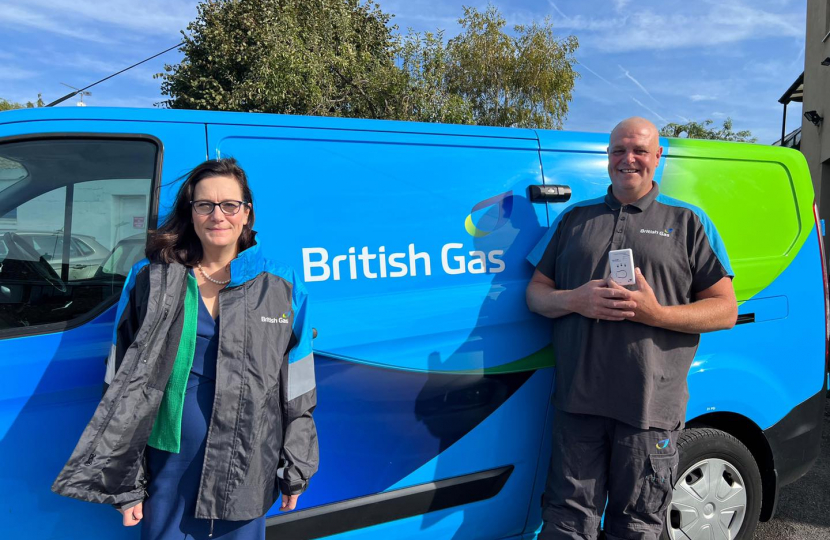
As part of Gas Safety Week, British Gas kindly offered to drop off some Carbon Monoxide alarms for Rebecca to give to local charities.
While they were here, Rebecca asked them for some top tips for keeping houses warm and bills low this winter. This is the advice they sent me:
1.Bleed your radiators: Air can enter the system and form bubbles at the top of your radiators, which stops them from working efficiently. If you notice cold spots at the top of your radiators, switch them off and after they cool, turn a radiator key in the valve at the top to let the air out.
2.Shut out the cold: You wouldn’t leave the back door open when the heating’s on, but warm air could still be escaping without you realising – and cold air could be sneaking in. Draught excluders are available from most DIY stores, and they’re an easy and affordable way to draught-proof your home. As well as sealing the joins around your doors and windows, don’t overlook extra measures like letterbox brushes, chimney balloons and even keyhole coverings.
3. Turn off radiators in rooms not in use: It’s important not to spend money heating spare rooms or other rooms not in use during the winter, so if you know a room isn’t going to be used then make sure you turn the radiator off and close the door to stop cold air circulating through the rest of the house. When you do need to use the room just turn it back on ahead of time to heat it up.
4. Check boiler pressure: The first sign of a low-pressure boiler is if your heating or hot water isn’t working properly. But to find out for sure, check the water pressure gauge on the front on your boiler. This will be either a hydraulic dial or a digital reading. Ideally, the gauge should read between 1 and 1.5. But if it reads less than 1 bar, your boiler pressure is too low and needs re-pressurising.
5. Reduce your boiler flow temperature: Got a combi boiler? The default boiler flow temperature is normally set at 70 degrees. Reduce it to 55-60 degrees to save up to 6% on your energy use. Your boiler will work much more efficiently, and you won’t even notice the difference. Sound complicated? It really isn’t!
6. Furnish for warmth: Think about where your heat sources are, and make sure your radiators can do their job properly. Putting your sofa in front of a radiator will absorb heat that could be warming the rest of the room. Curtains and rugs have an important part to play as well, because thick material prevents heat from being lost through windows and doors – just don’t forget to open your curtains during the day so that the sun can do some of the work.
7. Get your heating right for bedtime. Set your heating to start 15 minutes before you wake up and turn off 30 minutes before bed. This can save money and even help you get a better night’s sleep. You can also turn down the heat in any rooms not in use.
8. Wrap your pipes up warm: We often come across frozen condensate pipes – which can burst or crack when the water inside turns to ice. The best solution is to stop the water inside your pipes from freezing in the first place. Insulating materials are an easy, cost-effective solution, available from most DIY stores – it will ensure the pipes don’t lose heat saving an average of £15 on your bills and preventing any costly repairs.
9. Heat your home, not your walls: Cover a thin sheet of card with tinfoil and place it behind your radiators (if you're feeling particularly crafty you can make it T-shaped so it sits on your radiator brackets). It'll reflect the heat back into your rooms, meaning they warm up faster and retain more heat. If DIY isn't your thing, you can also buy ready-made foil insulation. Households can save around £25 a year doing this depending on the insulation in their home.
10. Check your thermostat settings: It’s easy to turn the thermostat all the way up when it's freezing cold but what temperature should your house be? Aim to set your main room thermostat somewhere between 18°C and 21°C and you can save around 10 percent on your heating bills – an average of £115 a year – by turning it down by 1 degree. It's also a good idea to set your thermostat to one temperature and then use a timer to turn it on and off when you need the heating most. That way you won't waste excess energy from leaving the heating on too high, for too long.
11. Make a plan B: Do you know where your stopcock is? In the rare event that your pipes freeze up, you'll want to prevent a build-up of pressure forming behind the blockage and leading to a burst pipe. It’s important to familiarise yourself with the location of your stopcock and to make sure that you can access it easily. It’s the little tap or lever on your copper pipes, often found under your sink.
